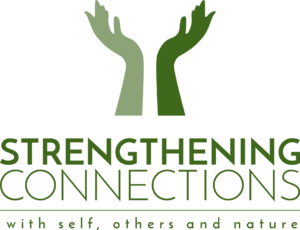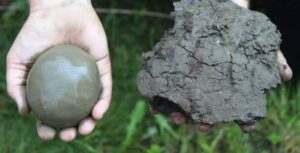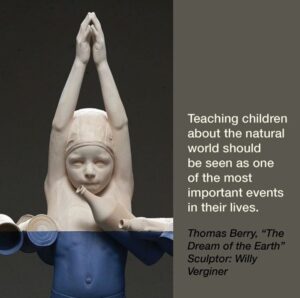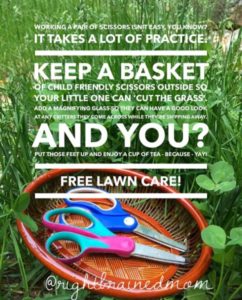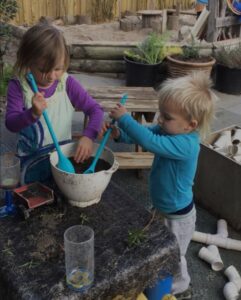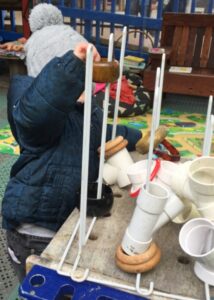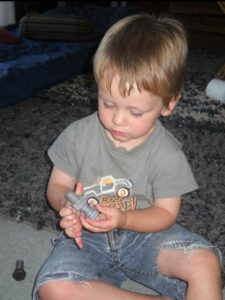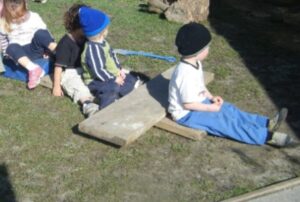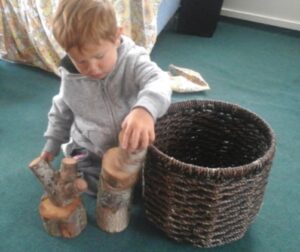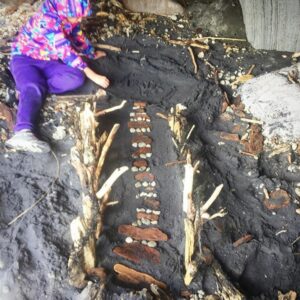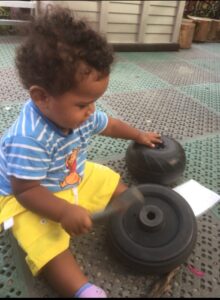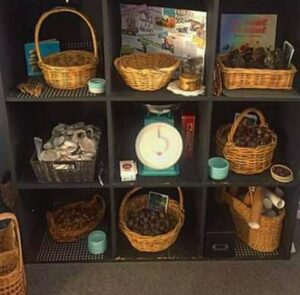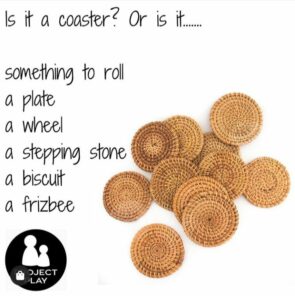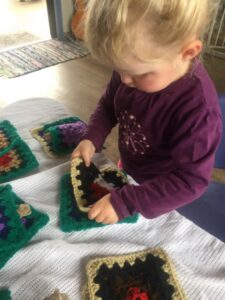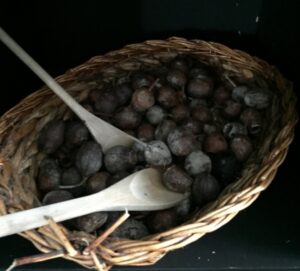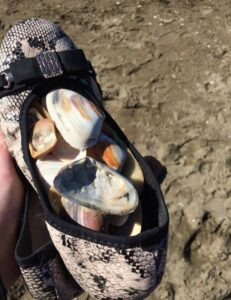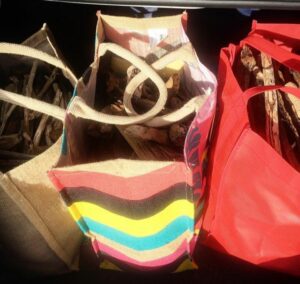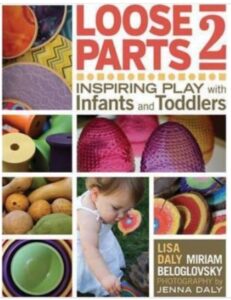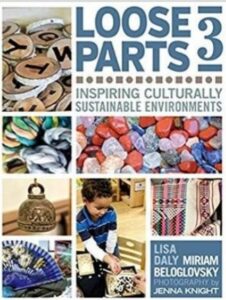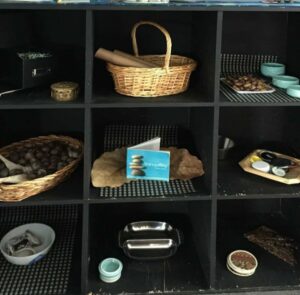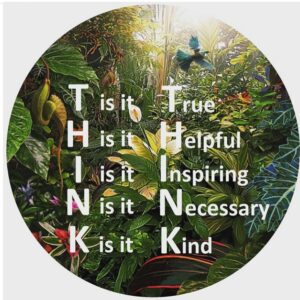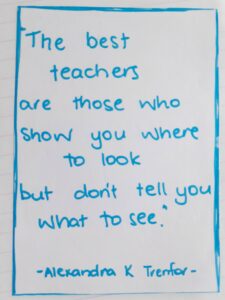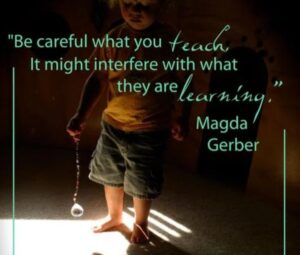Loose parts are simple resources that promote complex thinking, play and learning.
The simplicity of Loose Parts foster learning through promoting complex thinking. ‘Lots of the same’ encourages imagination, creativity, planning, problem solving, curiosity and connection.
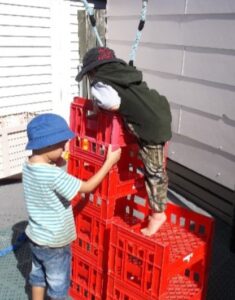
We can introduce Loose Parts at any time and you probably already have many available for children. Lots of the same is the key. Check out my previous post Loose Parts – as Learning Resources for more on the value and introduction of Loose Parts in your play space.
The teachers role in using Loose Parts as a learning resource:
1. Observe (from afar)
2. Recognize learning/urges
3. Respond through environmental change
4. Maintain and Refresh the space.
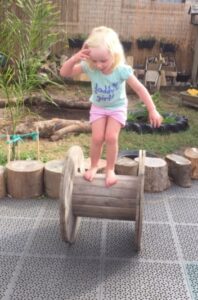
1. Observe
“We need to prioritise play
Not guided
No agenda
Open ended, Child Led play
Let them lead.
While you Listen, look, watch and notice”.
– Kimberley Crisp
The more engrossed the play is, the more learning there is to recognize and respond to. While children play, we observe, watch and listen. Knowledge is power. We need to watch play in action in order to respond meaningfully.
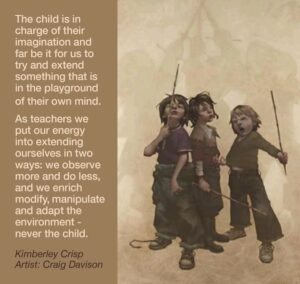
In order to observe play in action, we need to give the children the time and space to become engrossed in their play, then the true learning happens.
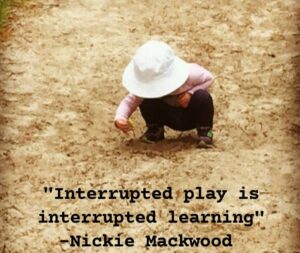
This can be a mind shift. For years we have been taught to comment, extend, talk to and work alongside the children in their play. Yet children learn far more authentically and on a deeper level when we allow them the opportunity to get full engrossed in their work.
We must ensure children get uninterrupted time and space to play out their learning. This is crucial.
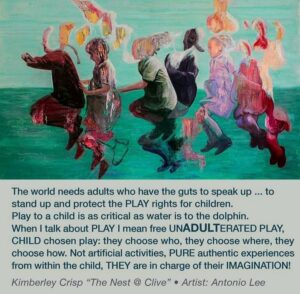
2. Recognize and Respond
When we understand how children learn, we can respond by providing an environment that supports and enhances learning in a safe, supportive and responsive way.
I have learned, actively responding to childrens’ innate play urges makes for meaningful and rewarding teaching.
If you dont know about or understand childrens’ innate play urges/schemas, this is stage one of understanging the value of Loose Parts and the teachers role in an environment rich in them.
We as teachers need this information in the forefront of our thinking.
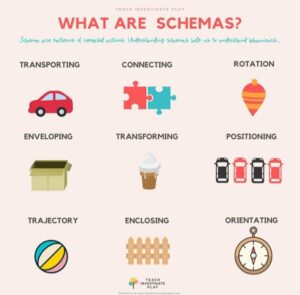
Example…Perhaps we notice a child with a trajectory urge… we could respond by sourcing resources that allow this child to play out this urge safely… balls, coasters, loafers, perhaps some buckets and baskets for the child to throw in to.
Or, maybe you notice a rotation urge – we can respond with wheels, balls, tyres, piping, cogs, cable reels etc.
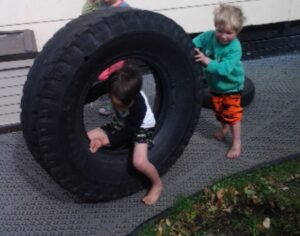
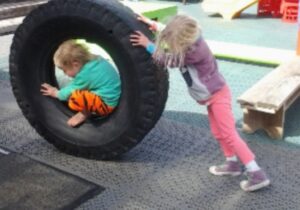
The collecting, transporting and deconstruction urges can be challenging for teachers. As you can imagine, with lots of the same, Loose Parts are gathered and collected and they get spread around the play space.
We need to be prepared for this and put some thought into the Loose Parts you provide when these urges are strong.
Large resources are easier to gather and refresh… driftwood, sticks, pinecones, pumice, drainage fittings, log rounds big and small, mill crates, large piping, types, planks and blankets/sheets.
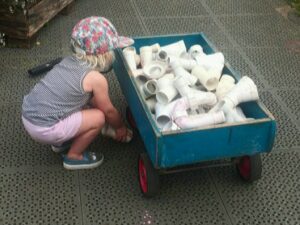
Lots of baskets, bags, boxes, trolleys, wheelbarrows and barrels for collecting, storing and transporting.
Rakes and brooms are useful for ease of gathering, refreshing and maintaining the play space.
When we think wisely, we can support both the children and the teachers.
4. Maintain and Refresh the environment
While the children play, teachers refresh.
Loose Parts are exactly that, LOOSE. Lots of resources that can end up scattered all over the place. As a result, there is a lot of refreshing to be done, which can be viewed as ‘picking up and tidying’.
This can come with some resistence from teachers. Again, it is a mind shift. Our role is different to what we have known for so long. It can be challenging to change our practice, but when we can recognize the value of uninterrupted and unadulterated play, it becomes easier to acceptance and embrace the change.
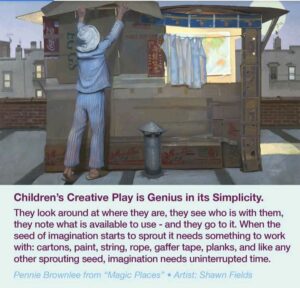
Remember… The spread of resources occurs because of all the learning that happened before that moment.
“To adults, it (Loose Parts) looks like junk, but we have to get rid of the aesthetically pleasing image of play out of our heads.”
– Leah and the First Years
When refreshing and maintaining an environment rich in Loose Parts, the positives definitely outweigh the negatives.
Refreshing gives us great opportunities to observe, from the outskirts of the play. This is potentially our most valuable position… Where we look busy, yet all of our senses are working. We are present, from afar. We can listen intently to the conversations nearby, watch that child working hard to climb and balance…, take a photo and make some notes to wrte a meaningful story about it all later. Refreshing gets us close enough to show presence, yet not close enough to interrupt. This can be very effective when conflict arises. Often just a slight (non-threatening) adult presence can be all that is needed to calm a situation.
When we refresh and replenish – we provide each child with the rich environment that the one before had. Each child will explore same materials in totally different ways, highlighting the value of refreshing and maintaining, thus rewarding our efforts and encouraging us to provide the same for the next child. We are the home makers. We maintain and refresh the environment for rich learning to occur.
Remember to ensure the child/ren are finished in the space before you start refreshing. They have worked hard, a lot of effort, learning, thinking and fun has been had, please be respectful of this. They may need photos of their work to share with their family, or they may want to continue this work later. There is nothing worse than working hard on something for someone to undervalue it by destroying it, labeling it as mess. Be mindful of the energy we put out. Speak negatively of the situation and what does that teach?
This ‘mess’ was authentic learning in action. Whether you observed it or not, the learning was there.
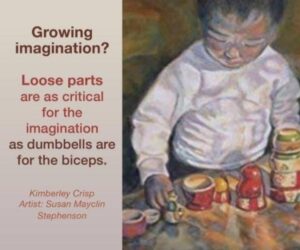
Use this time as a time to connect with children nearby. They will surely see you and ask questions or naturally want to help and join you. This is when you can talk about refreshing the space for others. Model respect and kindness.
Choose to make refreshing be a joyous task. It can be a time to gather your thoughts, observe meaningful learning in action, an opportunity to connect with the leaning environment and the resources within it. Do it with a smile, it will feel much better.
Choose a positive perspective, notice the good
the value in the play. Watch to notice… What are the children learning? What skills are they developing during this play?
Create a space you want to spend time in, so it doesnt feel like work, and more like ‘pottering’.
Work to love the environment like we do our home. Refresh it, maintain it and fill it with beauty and joy.
How can we support Resistance from the teachers
Resistence usually happens because of misunderstanding/misconception.
It is natural to feel resistance when a new concept is introduced. When we understand the reasoning and benefits of the new concept/practice, it is easier to develop acceptance.
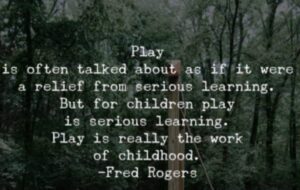
Perhaps the most valuable way I have learned to tackle this, is to go on the journey together. Start an internal review. Do the research together. Attend professional learning opportunities together, share your reflections and challenges.
Resistence can be supported in a number of ways…
• Highlight the benefits and the valuable learning that is occurring.
• Capture and document these moments in learning stories,
• Share the the learning moments with families and fellow team members.
• Discuss the value of the simple resources that foster complex play and learning
• Role model. Share your joy and excitement for connection and learning.
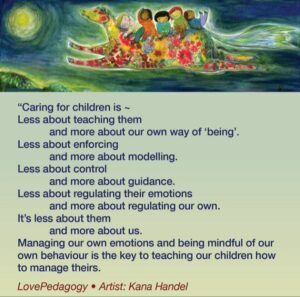
The ‘DUMP’
Perhaps the most challenging play that can come with Loose Parts, is ‘dump’s’ …. this type of play may seem meaningless on the surface, but when you observe closer, the learning becomes visible.
*’Dumps’ typically happen when Loose Parts are initially introduced. Before the children have connected with the loose parts. The urge does pass*
We had a dump for over a week! This challenged our teachers on so many levels.
After refreshing on day one for the children to revisit the play again the next day, we decided not to undo the work this time and watch to see how it developed. This became a reflective learning moment for us all.

Kimberley Crisp
The next day, the main players were there again. There were newcomers too. The children continued their play and throughout the morning, the play developed. There was a ticket person, a commander, searchers, sorters and transporters. There were road workers directing traffic with stop and go signs and a pathway drawn on the ground to follow.
The children were leading the play. The learning was developing as children worked together, sharing their ideas, knowledge and opinions. They were communicating, navigating, problem solving, planning and sharing.
Literacy concepts were explored with the inclusion of signs and symbols and early math concepts were introduced with the tickets and sorting. This was just the learning on the surface. There was so much more happening for each individual child.

So many children were involved in this, with varying ages and stages of development. Each person had a part and played a role suitable to their own learning needs. The children were communicating with each other. Listening, sharing, planning, negotiating, solving problems and navigating social competencies. We were able to watch this all unfold. Recognizing there was great value in this play.
When all of this learning was highlighted to adult onlookers, visitors and teachers, a sense of understanding and shared value was recognized.
…Just think, if we had refreshed the dump at the end of the day yesterday, the play would have had to start again from the beginning. Would the play have developed the same?
For the teachers, the ‘dump’ provided a great opportunity to clean the storage boxes as they were empty. It also enabled us to look busy while observing play and learning from the outskirts.
As children dispersed from the space, I slowly started collecting and sorting. Gaging the response from the children, listening and watching.
I was not focused on getting it all put away. I just wanted to minimize it a little, so I slowly stated collecting a box of plumbing fittings.
I did most of this ‘pottering’ silently but when asked, I talked about how at the dump things are sorted so I was doing my bit to help. This drew interest…. some children watched, some talked and asked questions and others helped.
There was no hurry or need to have it all sorted and put away. I was minimizing the mountain and refreshing some resources to provoke play and thinking in other ways. My actions were not calling an end to the play, my choice of words kept the opportunity open for the play to continue.
I took the box of fittings to another space and quietly started to build, balance a create with them.
Leah and the First Years reminds us:
“It can take some time for children to get used to using Loose Parts in their play. Especially if they are used to working with ‘toys’ that do all the thinking work for them… an apple is an apple” whereas a stick, tyre or blanket can be used in so many ways.
The ‘dump’ play allowed the children to connect with the materials, it allowed them to discover what was available to them, it had them searching the play space for things to use. This was the beginning of complex learning with simple resources.
As the children moved through this urge over the coming days, the play began to change. The children started connecting with the resources and using them in different ways.
The dump materials were being collected to use in other play. “I know what we could use”. ” I know where theres a good stick”
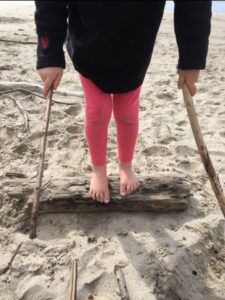
The ‘dump’ also allowed me the opportunity to connect with the resources. Observation, reflection and presence in the learning, helped me form a positive relationship with the concept of loose parts.
The next day I mindfully set up inviting play spaces to capture interest and show different ways of using loose parts.
As the team worked together to provide inviting provocations in our environment, it challenged our thinking, imagination and creativity…. It was challenging, it made us work together and communicate… just like it does for the children. We had interest in observing how the children played in these spaces, causing reflection and further collaboration.
This was the beginning of the teachers developing a positive relationship with Loose Parts as a learning resource.
‘Dumps’ WILL occur. ‘Dumps’ allow children to work through innate play urges… collecting, transporting and deconstructing. They will work through this and as they build a connection with the materials, their play will develop into more complex play.
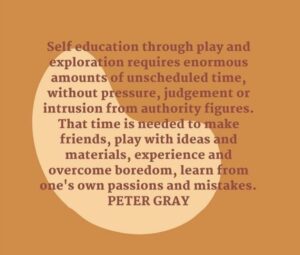
Ultimately, the teachers role in using Loose Parts for learning, is to observe the play, recognize the learning, respond to learning and provide an environment that is maintained and refreshed to promote thinking, connection and play.
TIPS
Storage
An environment rich in Loose Parts needs a storage area filled with baskets, buckets and bowls. Tools to support easy refreshing – brooms, rakes, helping hands, trolleys.
Collect and source
Encourage your team and families to source Loose Parts. Be willing to reimburse small costs and remember to Thank them for their time and effort.
Actively Reflect on the learning we see in action and How we can enhance the environment?
Read and research.
Start here:
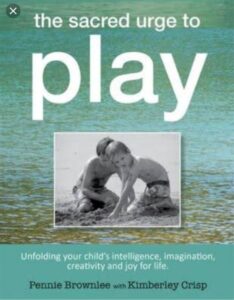
The Sacred Urge to Play
Pennie Brownlee with Kimberley Crisp
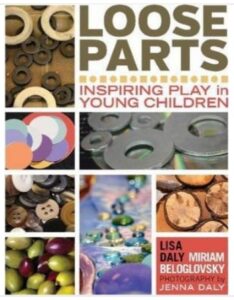
Loose Parts book 1 by Lisa Daly

Designs for living and learning by Deb Curtis and Margie Carter
Alternatively, if you are in New Zealand,
Check out Professional Learning Development with:
• Kimberley Crisp
• Pennie Brownlee
• 4Es Consulting
• Longworth Education
• Junky Monkeys (Auckland only).
Wishing you happy refreshing as you observe serious play in action.
